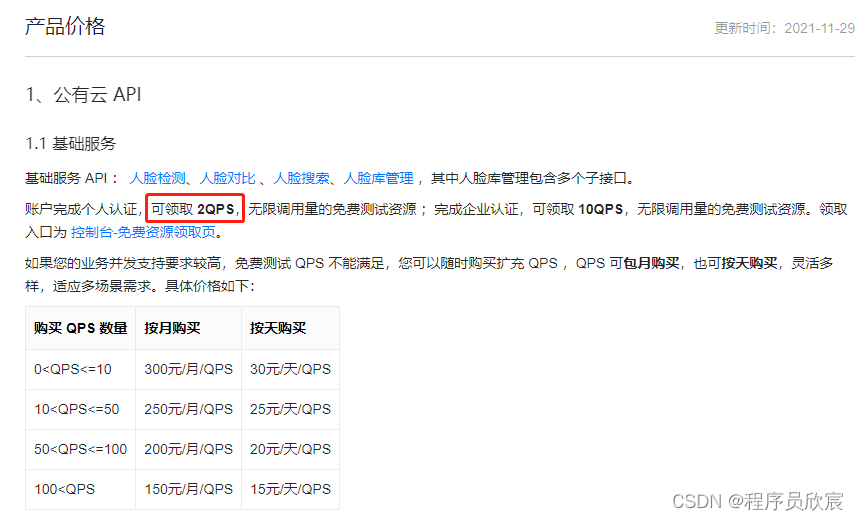最簡單的人臉檢測(免費呼叫百度AI開放平臺介面)
2023-07-04 09:01:38
遠端呼叫百度AI開放平臺的web服務,快速完成臉部辨識
歡迎存取我的GitHub
這裡分類和彙總了欣宸的全部原創(含配套原始碼):https://github.com/zq2599/blog_demos
本篇概覽
- 在檢測人臉數量、位置、性別、口罩等場景時,可以考慮使用百度開放平臺提供的web介面,一個web請求就能完成檢測得到結果,本篇記錄了從申請到真實呼叫的完整過程,由以下步驟組成:

註冊百度賬號
- 按照您的實際情況,註冊個人或者企業賬號,這個不多說了
登入百度智慧雲
- 使用剛才註冊號的賬號登入,地址是:https://login.bce.baidu.com/
實名認證
- 開啟百度智慧雲的控制檯:https://console.bce.baidu.com/
- 如下圖,點選下圖紅框中的兩個按鈕,完成啟用和實名認證:
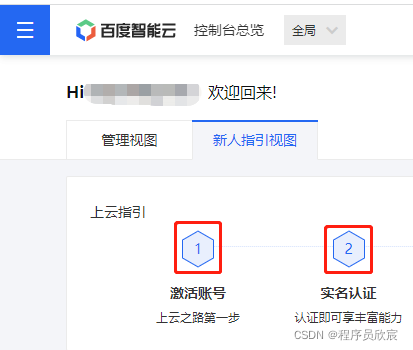
建立應用
- 為了能夠使用百度服務,需要建立一個應用
- 先選擇類別,在控制檯頁面,操作如下圖,點選紅框四:

- 此刻已跳轉到管理參照的頁面,點選下圖紅框中的建立應用
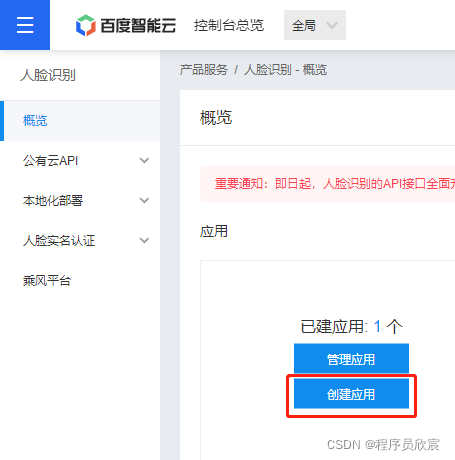
- 為了免費使用百度的服務,先點選下圖紅框中的去領取:
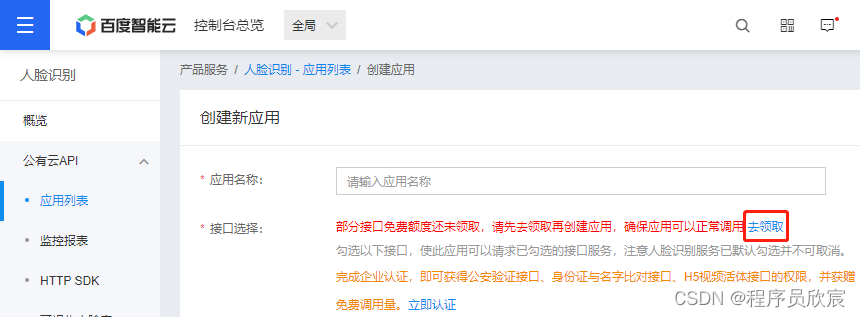
- 在領取頁面勾選人臉檢測:
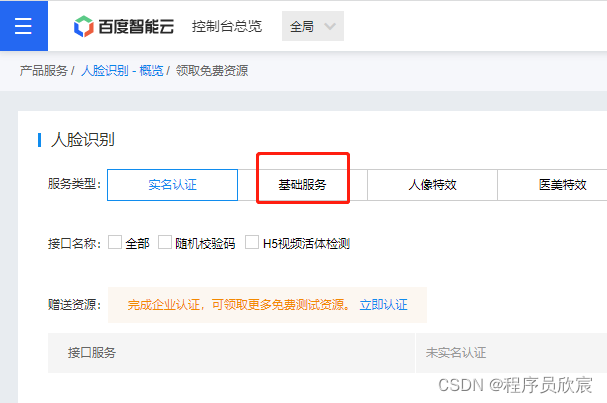
- 領取完成後,回到建立應用的頁面,發現這些服務已經被勾選,如下圖:

- 應用相關的資訊填寫完成後,提交表單即可完成建立應用
拿到API Key和Secret Key
- 在應用列表頁面拿到API Key和Secret Key,這些都是呼叫百度服務的關鍵授權資訊,如下圖紅框所示:

得到access_token
- 在使用百度提供的各種服務(如人臉檢測)的時候,需要帶上授權資訊證明你有使用該服務的許可權,這個授權資訊就是access_token
- 最簡單的方式就是curl命令獲取
curl -i -k 'https://aip.baidubce.com/oauth/2.0/token?grant_type=client_credentials&client_id=【百度雲應用的API Key】&client_secret=【百度雲應用的Secret Key】'
- 這裡用postman嘗試上述請求,如下圖,紅框中就是這次請求咱們要得到的access_token資訊:
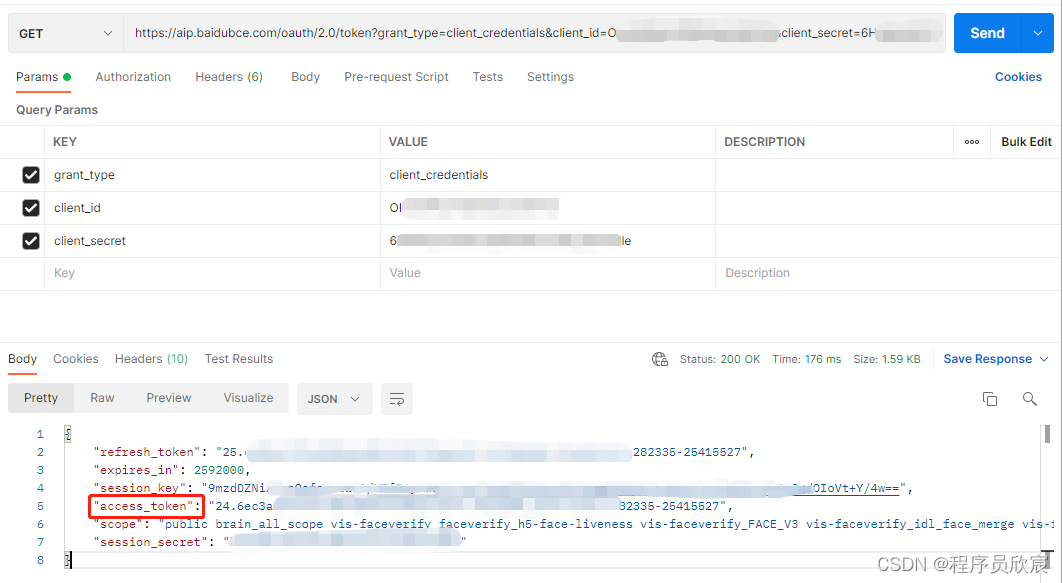
- 拿到access_token,就可以開始的呼叫百度的服務了,如下圖,官方檔案說了這個access_token的有效期是30天:

- 關於百度雲授權資訊的更多資訊請在此檢視:https://cloud.baidu.com/doc/FACE/s/Tkqahnjtk
編碼
- 百度關於人臉檢測的檔案:https://ai.baidu.com/ai-doc/FACE/yk37c1u4t
- 人臉檢測服務是個web介面,也能通過操作curl或者postman來完成,但是為了在程式碼中使用百度的服務,這裡寫一段程式碼來完成人臉檢測
- 今天的專案是個普通的maven工程,沒有使用spring或者spingboot框架,只有一些簡單的java類和main方法
- 首先要在專案中引入下面三個庫:
<!-- 快捷程式碼輔助庫 -->
<dependency>
<groupId>org.projectlombok</groupId>
<artifactId>lombok</artifactId>
<version>1.18.18</version>
</dependency>
<!-- 網路請求庫 -->
<dependency>
<groupId>com.squareup.okhttp3</groupId>
<artifactId>okhttp</artifactId>
<version>3.10.0</version>
</dependency>
<!-- JSON處理 -->
<dependency>
<groupId>com.fasterxml.jackson.core</groupId>
<artifactId>jackson-databind</artifactId>
<version>2.11.0</version>
</dependency>
- 先新建一個物件FaceDetectRequest.java,用於儲存請求引數:
package com.bolingcavalry.grabpush.bean.request;
import com.fasterxml.jackson.annotation.JsonProperty;
import lombok.Data;
/**
* @author willzhao
* @version 1.0
* @description 請求物件
* @date 2022/1/1 16:21
*/
@Data
public class FaceDetectRequest {
// 圖片資訊(總資料大小應小於10M),圖片上傳方式根據image_type來判斷
String image;
// 圖片型別
// BASE64:圖片的base64值,base64編碼後的圖片資料,編碼後的圖片大小不超過2M;
// URL:圖片的 URL地址( 可能由於網路等原因導致下載圖片時間過長);
// FACE_TOKEN: 人臉圖片的唯一標識,呼叫人臉檢測介面時,會為每個人臉圖片賦予一個唯一的FACE_TOKEN,同一張圖片多次檢測得到的FACE_TOKEN是同一個。
@JsonProperty("image_type")
String imageType;
// 包括age,expression,face_shape,gender,glasses,landmark,landmark150,quality,eye_status,emotion,face_type,mask,spoofing資訊
//逗號分隔. 預設只返回face_token、人臉框、概率和旋轉角度
@JsonProperty("face_field")
String faceField;
// 最多處理人臉的數目,預設值為1,根據人臉檢測排序型別檢測圖片中排序第一的人臉(預設為人臉面積最大的人臉),最大值120
@JsonProperty("max_face_num")
int maxFaceNum;
// 人臉的型別
// LIVE表示生活照:通常為手機、相機拍攝的人像圖片、或從網路獲取的人像圖片等
// IDCARD表示身份證晶片照:二代身份證內建晶片中的人像照片
// WATERMARK表示帶水印證件照:一般為帶水印的小圖,如公安網小圖
// CERT表示證件照片:如拍攝的身份證、工卡、護照、學生證等證件圖片
// 預設LIVE
@JsonProperty("face_type")
String faceType;
// 活體控制 檢測結果中不符合要求的人臉會被過濾
// NONE: 不進行控制
// LOW:較低的活體要求(高通過率 低攻擊拒絕率)
// NORMAL: 一般的活體要求(平衡的攻擊拒絕率, 通過率)
// HIGH: 較高的活體要求(高攻擊拒絕率 低通過率)
// 預設NONE
@JsonProperty("liveness_control")
String livenessControl;
// 人臉檢測排序型別
// 0:代表檢測出的人臉按照人臉面積從大到小排列
// 1:代表檢測出的人臉按照距離圖片中心從近到遠排列
// 預設為0
@JsonProperty("face_sort_type")
int faceSortType;
}
- 其次是響應物件FaceDetectResponse.java:
package com.bolingcavalry.grabpush.bean.response;
import com.fasterxml.jackson.annotation.JsonProperty;
import lombok.Data;
import lombok.ToString;
import java.io.Serializable;
import java.util.List;
/**
* @author willzhao
* @version 1.0
* @description TODO
* @date 2022/1/1 13:30
*/
@Data
@ToString
public class FaceDetectResponse implements Serializable {
// 返回碼
@JsonProperty("error_code")
String errorCode;
// 描述資訊
@JsonProperty("error_msg")
String errorMsg;
// 返回的具體內容
Result result;
/**
* @author willzhao
* @version 1.0
* @description 返回的具體內容
* @date 2022/1/1 16:01
*/
@Data
public static class Result {
// 人臉數量
@JsonProperty("face_num")
private int faceNum;
// 每個人臉的資訊
@JsonProperty("face_list")
List<Face> faceList;
/**
* @author willzhao
* @version 1.0
* @description 檢測出來的人臉物件
* @date 2022/1/1 16:03
*/
@Data
public static class Face {
// 位置
Location location;
// 是人臉的置信度
@JsonProperty("face_probability")
double face_probability;
// 口罩
Mask mask;
/**
* @author willzhao
* @version 1.0
* @description 人臉在圖片中的位置
* @date 2022/1/1 16:04
*/
@Data
public static class Location {
double left;
double top;
double width;
double height;
double rotation;
}
/**
* @author willzhao
* @version 1.0
* @description 口罩物件
* @date 2022/1/1 16:11
*/
@Data
public static class Mask {
int type;
double probability;
}
}
}
}
- 這裡有一處要注意:FaceDetectResponse物件中的欄位是少於真實響應返回的欄位的,這是因為這個demo不需要完整的返回內容,因此只要選擇應用需要的欄位定義在FaceDetectResponse.java中即可
- 最後是完整的服務類BaiduCloudService.java,如下所示,即讀取圖片 -> 轉base64 -> 構造請求物件 -> 提交請求 -> 收到響應 -> 解析響應:
package com.bolingcavalry.grabpush.extend;
import com.bolingcavalry.grabpush.bean.request.FaceDetectRequest;
import com.bolingcavalry.grabpush.bean.response.FaceDetectResponse;
import com.fasterxml.jackson.databind.DeserializationFeature;
import com.fasterxml.jackson.databind.ObjectMapper;
import okhttp3.*;
import sun.misc.BASE64Encoder;
import java.io.FileInputStream;
import java.io.IOException;
import java.io.InputStream;
/**
* @author willzhao
* @version 1.0
* @description 百度雲服務的呼叫
* @date 2022/1/1 11:06
*/
public class BaiduCloudService {
// 轉換
BASE64Encoder encoder = new BASE64Encoder();
OkHttpClient client = new OkHttpClient();
static final MediaType JSON = MediaType.parse("application/json; charset=utf-8");
static final String URL_TEMPLATE = "https://aip.baidubce.com/rest/2.0/face/v3/detect?access_token=%s";
String token;
ObjectMapper mapper = new ObjectMapper();
public BaiduCloudService(String token) {
this.token = token;
// 重要:反序列化的時候,字元的欄位如果比類的欄位多,下面這個設定可以確保反序列化成功
mapper.disable(DeserializationFeature.FAIL_ON_UNKNOWN_PROPERTIES);
}
/**
* 將指定位置的圖片轉為base64字串
* @param imagePath
* @return
*/
private String img2Base64(String imagePath) {
InputStream inputStream = null;
byte[] data = null;
try {
inputStream = new FileInputStream(imagePath);
data = new byte[inputStream.available()];
inputStream.read(data);
inputStream.close();
} catch (IOException ioException) {
ioException.printStackTrace();
}
return null==data ? null :encoder.encode(data);
}
/**
* 檢測指定的圖片
* @param imageBase64
* @return
*/
public FaceDetectResponse detect(String imageBase64) {
// 請求物件
FaceDetectRequest faceDetectRequest = new FaceDetectRequest();
faceDetectRequest.setImageType("BASE64");
faceDetectRequest.setFaceField("mask");
faceDetectRequest.setMaxFaceNum(6);
faceDetectRequest.setFaceType("LIVE");
faceDetectRequest.setLivenessControl("NONE");
faceDetectRequest.setFaceSortType(0);
faceDetectRequest.setImage(imageBase64);
FaceDetectResponse faceDetectResponse = null;
try {
// 用Jackson將請求物件序列化成字串
String jsonContent = mapper.writeValueAsString(faceDetectRequest);
//
RequestBody requestBody = RequestBody.create(JSON, jsonContent);
Request request = new Request
.Builder()
.url(String.format(URL_TEMPLATE, token))
.post(requestBody)
.build();
Response response = client.newCall(request).execute();
String rawRlt = response.body().string();
faceDetectResponse = mapper.readValue(rawRlt, FaceDetectResponse.class);
} catch (IOException ioException) {
ioException.printStackTrace();
}
return faceDetectResponse;
}
public static void main(String[] args) {
// 圖片在原生的位置
String imagePath = "E:\\temp\\202201\\01\\pic\\1.jpeg";
// 百度雲的token,是通過此介面得到的:https://aip.baidubce.com/oauth/2.0/token
String token = "24.95xxxxxxxxxxxxxxxxxxxxxxxxxxxxxx.xxxxxxx.xxxxxxxxxx.xxxxxx-xxxxxxxx";
// 範例化服務物件
BaiduCloudService service = new BaiduCloudService(token);
// 將圖片轉為base64字串
String imageBase64 = service.img2Base64(imagePath);
// 向百度服務發請求,檢測人臉
FaceDetectResponse faceDetectResponse = service.detect(imageBase64);
// 輸出檢測結果
System.out.println(faceDetectResponse);
}
}
- 確保用於檢測的照片與上述程式碼中的路徑一致(E:\temp\202201\01\pic\1.jpeg),我這裡選用了一張戴口罩的單人照,如下圖:

- 執行BaiduCloudService的main方法,控制檯將百度返回的檢測結果列印出來,注意下面的內容並非JSON,而是lombok的@ToString註解拼接出的效果:
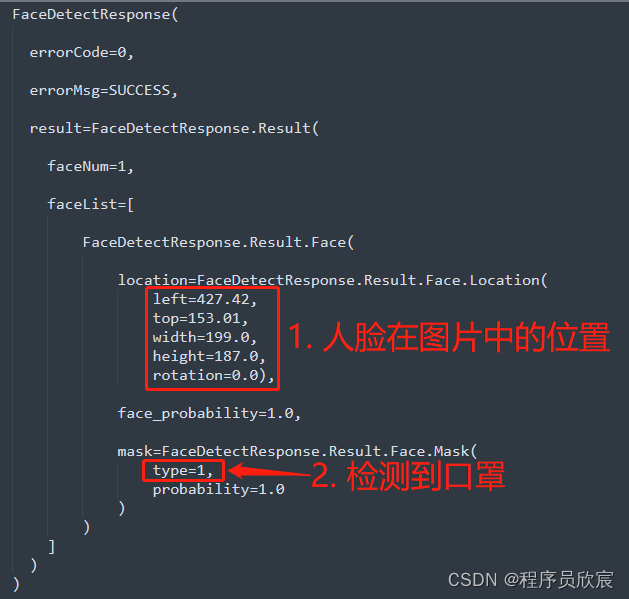
- 至此,通過百度的web介面呼叫人臉檢測的實戰已完成,可見有了雲平臺的支援,對於使用方來說開發過程變得非常簡單
使用限制
- 既然是免費的,就很難十全十美,這樣的web服務存在QPS限制,如下圖,一秒鐘不能超過兩個,如果完成了企業認證,可以增加到十個,如果依舊不能滿足需要,就只能付費了:
